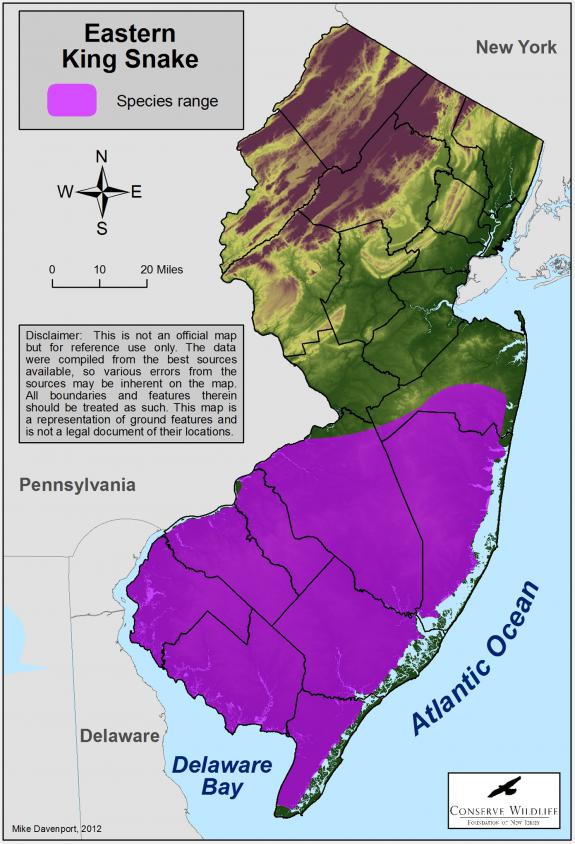Lampropeltis getula getula
Type: reptile
Status: special concern
Species Guide
Eastern king snake
Lampropeltis getula getula
Species Type: reptile
Conservation Status: special concern
IDENTIFICATION
The eastern king snake is a relatively large snake ranging from 36 to 82 inches in length. They can easily reach 5 feet and have even been known to reach 7 feet long. This snake is black with whitish-yellow chain-linked bands that cross the back and connect on the sides. The chains are usually broken up by black blotches down the entire body. It can also be called the “chain snake” due to the patterns on its body. The underbelly of the snake ranges from plain white to heavy blotches of darker pigmentation.

Distribution & Habitat
The eastern king snake is a subspecies of the common king snake (Lampropeltis getula). The common king snake has one of the largest geographic ranges of any North American snake. Common king snakes are found across North America from the Atlantic coast to the Pacific and from New Jersey, the Midwest, and Oregon in the north to Mexico in the south. Eastern king snakes are found throughout the eastern United States, from southern New Jersey in the north to Florida, Georgia, and South Carolina in the south. Southern New Jersey is the northeastern limit of the species’ range.
The eastern king snake inhabits pine forests, rocky areas, fields, swamps, and farmlands. They normally are found close to a water source. They can often be found seeking cover under boards, logs, tins, or other debris.
Diet
The eastern king snake is not a venomous snake but it is a strong constrictor. It captures its prey and kills it by squeezing with its coils until the prey can no longer breathe. This species will eat small mammals, birds, amphibians, fish, lizards, and even other snakes including venomous rattlesnakes.
Life Cycle
Male king snakes compete with each other for females. In some cases, two snakes fight for the female by intertwining their bodies and forcing the other snake down to the ground. The winning snake returns to the female to mate. Breeding season begins in mid-March and lasts until June. This allows females to lay the eggs in warmer weather to provide proper incubation temperatures. The incubation periods lasts about 8 to 11 weeks depending on the surrounding temperature. The baby snakes range from about 9 to 12 inches in length.
This snake is usually more active during then day than at night. However, in the summer months it becomes mostly nocturnal.
Current Threats, Status, and Conservation
Due to population declines and habitat loss, the eastern king snake was listed as a species of special concern in New Jersey. Reasons for the decline in their population are loss of habitat, illegal capture for the pet trade, road mortality, and direct killing. This species, like many snakes, has an undeserved bad reputation and they are often killed, which is illegal in New Jersey.
Conservation of this species is important not only because it is a beautiful creature, but it is beneficial to our environment. This species helps keep rodent populations in check and balances out other snake populations as well by preying on them.
HOW TO HELP
The Endangered and Nongame Species Program would like for individuals to report their sightings of eastern hognose snakes. Record the date, time, location, and condition of the animal and submit the information by submitting a Sighting Report Form. The information will be entered into the state’s natural heritage program, commonly referred to as Biotics. Biologists map the sighting and the resulting maps “allow state, county, municipal, and private agencies to identify important wildlife habitats and protect them in a variety of ways. This information is used to regulate land-use within the state and assists in preserving endangered and threatened species habitat remaining in New Jersey.”
Scientific Classification
- Kingdom: Animalia
- Phylum: Chordata
- Class: Reptilia
- Order: Squamata
- Family: Colubridae
- Genus: Lampropeltis
- Species: L. getula getula